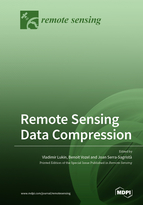Remote Sensing Data Compression
A special issue of Remote Sensing (ISSN 2072-4292). This special issue belongs to the section "Remote Sensing Image Processing".
Deadline for manuscript submissions: closed (31 March 2021) | Viewed by 51009
Special Issue Editors
Interests: multichannel remote sensing; image processing
Special Issues, Collections and Topics in MDPI journals
Interests: blind estimation of degradation characteristics (noise, PSF); blind restoration of multicomponent images; multimodal image correction; multicomponent image compression; multi-channel adaptive processing of signals and images; unsupervised machine learning and deep learning; multi-mode remote sensing data processing; remote sensing
Special Issues, Collections and Topics in MDPI journals
Interests: remote sensing data compression; source data coding
Special Issues, Collections and Topics in MDPI journals
Special Issue Information
Dear Colleagues,
Remote sensing has become a standard tool for solving a set of important tasks in areas such as agriculture, forestry, hydrology, ecology, urban planning, etc. A huge amount of data is acquired each day and they have to be transferred to image processing centers and/or to customers. Due to different limitations on one hand and rapid improvement of spatial resolution and increase of channel number on the other, compression has to be applied on-board and/or on-the-ground.
Despite great successes gained in design of data compression methods, there are still many unsolved tasks. It is planned that this Special Issue will address all aspects of compression methodology and applications including but not limited to:
- Advances in lossless compression;
- Multi- and hyperspectral image compression;
- Radar image compression;
- Applications of remote sensing data compression;
- Compression standards;
- Practical implementation of image compression techniques;
- Data compression hardware and software;
- Impact of data compression on solving classification and identifications tasks.
Dr. Benoit Vozel
Dr. Joan Serra-Sagristà
Guest Editors
Manuscript Submission Information
Manuscripts should be submitted online at www.mdpi.com by registering and logging in to this website. Once you are registered, click here to go to the submission form. Manuscripts can be submitted until the deadline. All submissions that pass pre-check are peer-reviewed. Accepted papers will be published continuously in the journal (as soon as accepted) and will be listed together on the special issue website. Research articles, review articles as well as short communications are invited. For planned papers, a title and short abstract (about 100 words) can be sent to the Editorial Office for announcement on this website.
Submitted manuscripts should not have been published previously, nor be under consideration for publication elsewhere (except conference proceedings papers). All manuscripts are thoroughly refereed through a single-blind peer-review process. A guide for authors and other relevant information for submission of manuscripts is available on the Instructions for Authors page. Remote Sensing is an international peer-reviewed open access semimonthly journal published by MDPI.
Please visit the Instructions for Authors page before submitting a manuscript. The Article Processing Charge (APC) for publication in this open access journal is 2700 CHF (Swiss Francs). Submitted papers should be well formatted and use good English. Authors may use MDPI's English editing service prior to publication or during author revisions.








